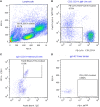Identification of a HIV Gp41-Specific Human Monoclonal Antibody With Potent Antibody-Dependent Cellular Cytotoxicity
- PMID: 30519238
- PMCID: PMC6251304
- DOI: 10.3389/fimmu.2018.02613
Identification of a HIV Gp41-Specific Human Monoclonal Antibody With Potent Antibody-Dependent Cellular Cytotoxicity
Abstract
Antibody-Dependent Cellular Cytotoxicity (ADCC) is a major mechanism of protection against viral infections in vivo. Identification of HIV-1-specific monoclonal antibodies (mAbs) with potent ADCC activity may help develop an effective HIV-1 vaccine. In present study, we isolated such human mAb, designated E10, from an HIV-1-infected patient sample by single B cell sorting and single cell PCR. E10 bound to gp140 trimer and linear peptides derived from gp41 membrane proximal external region (MPER). E10 epitope (QEKNEQELLEL) overlapped with mAb 2F5 epitope. However, E10 differentiated from 2F5 in neutralization breadth and potency, as well as ADCC activity. E10 showed low neutralization activity and narrow spectrum of neutralization compared to 2F5, but it mediated higher ADCC activity than 2F5 at low antibody concentration. Fine mapping of E10 epitope may potentiate MPER-based subunit vaccine development.
Keywords: ADCC; HIV; MPER; antibody; epitope; gp41.
Figures





Similar articles
-
Interaction of anti-HIV type 1 antibody 2F5 with phospholipid bilayers and its relevance for the mechanism of virus neutralization.AIDS Res Hum Retroviruses. 2011 Aug;27(8):863-76. doi: 10.1089/AID.2010.0265. Epub 2011 Jan 15. AIDS Res Hum Retroviruses. 2011. PMID: 21142698
-
Monoclonal Antibody 2C6 Targets a Cross-Clade Conformational Epitope in gp41 with Highly Active Antibody-Dependent Cell Cytotoxicity.J Virol. 2019 Aug 13;93(17):e00772-19. doi: 10.1128/JVI.00772-19. Print 2019 Sep 1. J Virol. 2019. PMID: 31217246 Free PMC article.
-
Prolonged exposure of the HIV-1 gp41 membrane proximal region with L669S substitution.Proc Natl Acad Sci U S A. 2010 Mar 30;107(13):5972-7. doi: 10.1073/pnas.0912381107. Epub 2010 Mar 15. Proc Natl Acad Sci U S A. 2010. PMID: 20231447 Free PMC article.
-
Epitope specificity of human immunodeficiency virus-1 antibody dependent cellular cytotoxicity [ADCC] responses.Curr HIV Res. 2013 Jul;11(5):378-87. doi: 10.2174/1570162x113116660059. Curr HIV Res. 2013. PMID: 24191939 Free PMC article. Review.
-
The development of HIV vaccines targeting gp41 membrane-proximal external region (MPER): challenges and prospects.Protein Cell. 2018 Jul;9(7):596-615. doi: 10.1007/s13238-018-0534-7. Epub 2018 Apr 17. Protein Cell. 2018. PMID: 29667004 Free PMC article. Review.
Cited by
-
HIV-1 Vpu restricts Fc-mediated effector functions in vivo.Cell Rep. 2022 Nov 8;41(6):111624. doi: 10.1016/j.celrep.2022.111624. Cell Rep. 2022. PMID: 36351384 Free PMC article.
-
Enhancing natural killer cell function with gp41-targeting bispecific antibodies to combat HIV infection.AIDS. 2020 Jul 15;34(9):1313-1323. doi: 10.1097/QAD.0000000000002543. AIDS. 2020. PMID: 32287071 Free PMC article.
References
-
- Gómez-Román VR, Patterson LJ, Venzon D, Liewehr D, Aldrich K, Florese R, et al. Vaccine-elicited antibodies mediate antibody-dependent cellular cytotoxicity correlated with significantly reduced acute viremia in rhesus macaques challenged with SIVmac251. J Immunol. (2005) 174:2185–9. 10.4049/jimmunol.174.4.2185 - DOI - PubMed
Publication types
MeSH terms
Substances
LinkOut - more resources
Full Text Sources
Medical

